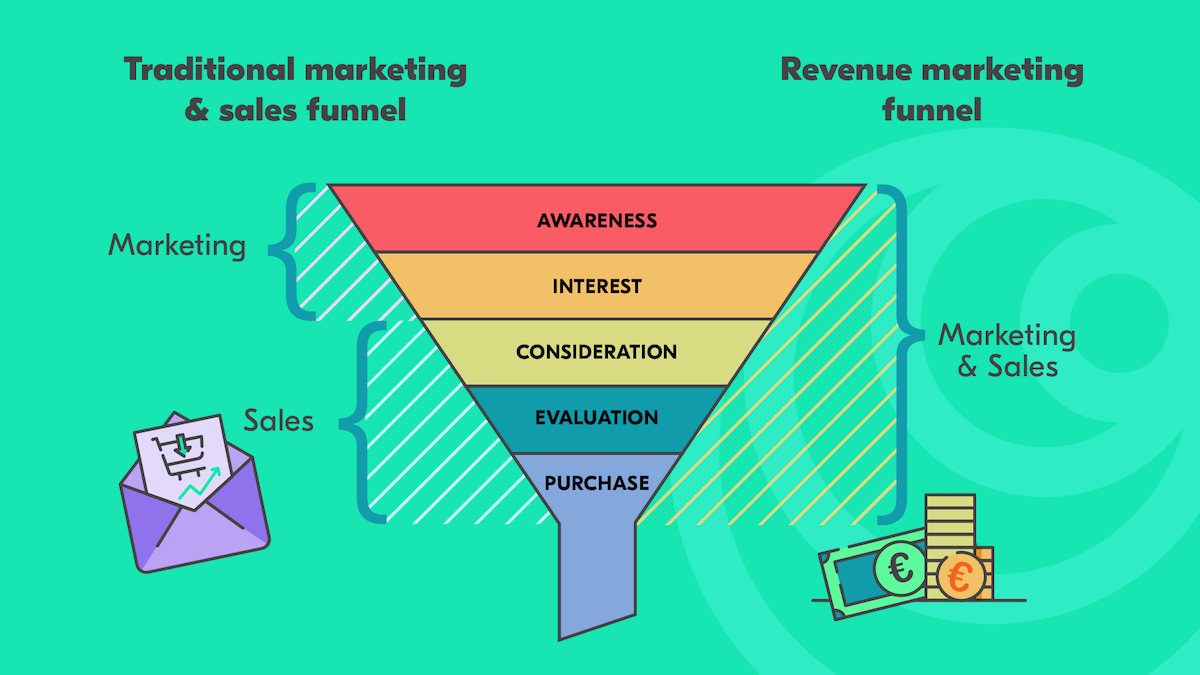Last updated: Aug 6th, 2025
The path to major breakthroughs often begins with getting the definitions right. When you’re in charge of acquisition for a company, how do you define the thing that you do in the best possible way?
Demand generation is a useful practice, but it largely ignores what the end-user wants and stops at handing leads over to sales.
Growth marketing is a very popular concept, and while it’s definitely the way to go for B2C companies, it too doesn’t often involve the sales function. Also, when applied superficially, growth marketing can lead you down the path of one tactic on top of another, without a coherent strategy.
Account-Based Marketing and Account-Based Experience are increasingly popular approaches, but only suitable if your deal sizes are big (read: compatible with enterprise sales).
In this post, I’ll make the case that revenue marketing is the right approach for many B2B companies. I’ll show you how this concept can help you align sales and marketing and, well, grow your revenue.
What is revenue marketing?
Here’s how we define revenue marketing.
DEFINITION
Revenue marketing is a holistic goal-oriented approach to marketing and sales, used by companies to drive revenue growth predictably.
When done well, revenue marketing aligns marketing and sales around this common goal by creating a continuous feedback loop between sales (data) and marketing (data).
2025 reality check: Modern revenue marketers also loop product and customer-success insights back into campaigns, using first-party data and AI-powered analytics to keep that feedback loop always-on.
Why is revenue marketing important (in 2025)?
Operating sales and marketing in silos worked well enough in the days most classic sales and marketing books were written. In the traditional model, marketing generated leads and handed them over to sales for closing.
Now, B2B buying is increasingly self-directed. So, marketing and sales need to support the customer in a holistic, contextual, and helpful way, throughout their entire lifecycle.
The funnel has changed.
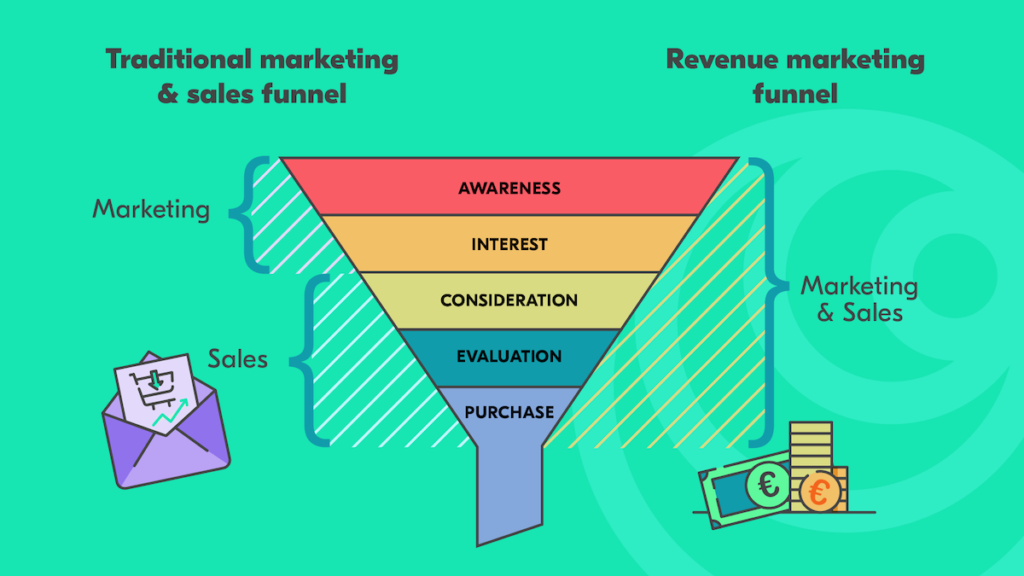
Now, just to be clear — this does not mean sales reps should start cold-calling the leads at the top of the marketing funnel. Rather, it means that they are aware of what goes on in the entire funnel and are able to use it to their benefit.
📊 Nielsen Marketing Pulse 2025: 64 % of CMOs list “pipeline contribution” as their #1 success metric—up from 48 % in 2022.
Marketers can no longer consider it a “job done” when they have moved a lead to the consideration or intent stage. Instead, they create collateral that supports the entire lifecycle and learn which marketing channels, emails, and collateral work best to drive revenue.
What are the main benefits of revenue marketing?
Here are the three key ways in which revenue marketing brings value to everyone involved:
- Sales instantly sees which prospects are sales-ready and has the necessary context they need to close the sale.
- Marketing learns which campaigns, channels, messages, and touchpoints influence revenue, so they can optimize ROI.
- Last but not least: the customer always receives the most relevant communication. This allows them to move faster through the funnel or speed up their decision to abandon.
We trust you agree that these benefits are worth fighting for. Yet, according to the 2024 Demand Metric Revenue Alignment Survey, only 57% of marketers feel empowered to collaborate with sales or share their goals.
If 100% of the business buyers have moved on from traditional B2B buying cycles and only 50% of the companies’ sales and marketing work together to serve today’s buyers, who do you think will win?
Run sales and marketing workflows across all tools
Sync data, score leads, and trigger the best next step with each lead.
Seamless integrations with Pipedrive, HubSpot, Salesforce, and Copper.
Revenue marketing strategy in 4 steps (none of which is easy)
If you’re ready to be among the winning teams in today’s B2B world, then read on. It is time to explore how you can make revenue marketing work at your company.
Implementing a revenue marketing strategy probably won’t mean scratching everything you’ve worked on so far and starting from square one. Rather, it offers an opportunity to review your marketing and sales efforts and ensure they are effective in driving revenue growth.
We boiled the revenue marketing strategy down to a 4-step process.
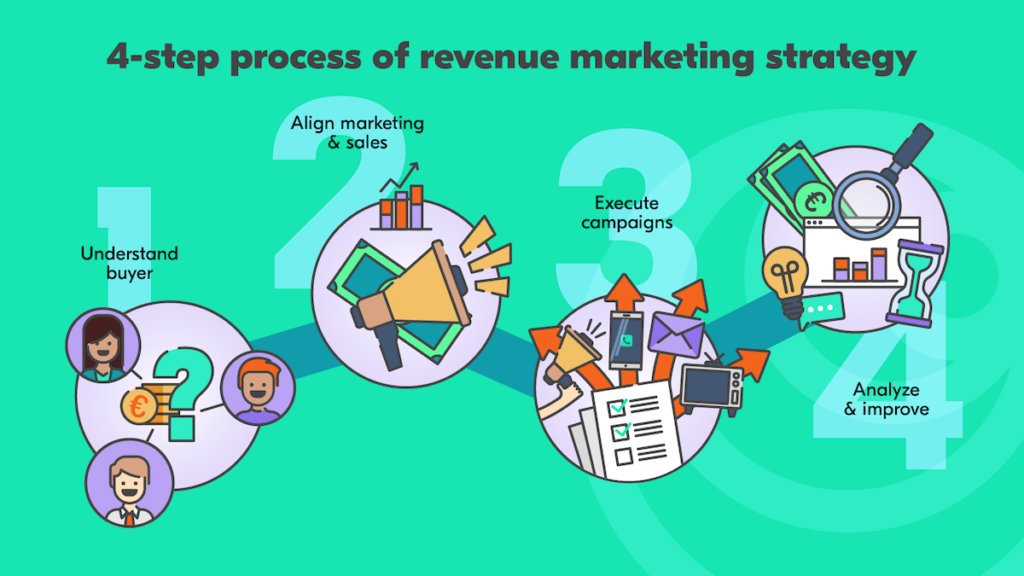
1. Understand the buyer
The first part of your revenue marketing strategy is to develop a deep understanding of your buyer. This involves figuring out their needs and mapping out the buying cycle.
For a deep understanding of the customer’s needs, you need to do some heavy lifting. You can create detailed buyer personas or any other form of marketing research to map the needs of the customers. One recently popularized framework you may want to consider using is the “Jobs to be Done” (JTBD) framework.
The JTBD framework is great because it forces you to think about the single most crucial thing you need to know about your buyer: what they hope to accomplish. In the JTBD lingo, what is the job to be done.
This means the product or service helps the customer get the job done. In other words, the buyer can “hire” your product or service to get the job done.
Once you have an understanding of your customer’s needs or the job they need to be done, you need to evaluate their buying cycle.

The buying cycle stands for the series of stages the customer goes through when purchasing a product or service. It is important to understand the buying cycle in order to line up your marketing and sales efforts to support their buying process.
While the exact buying cycle looks different for each company, you can loosely think of the marketing & sales funnel as a basis on which to map the buying cycle. At the end of the day, it’s most important that you understand the specifics of how your customer goes through the key stages of buying:
- Awareness: realizing they have a problem
- Consideration: looking at their options
- Deciding: purchasing a solution
Read more about 5 buying cycle stages and using JTBD in client or user onboarding.
Don’t forget to analyse product-usage data, too. In 2025, usage signals often out-predict firmographic traits when it comes to churn and upsell.
Armed with a full understanding of your buyer, you can move forward with the next step.
2. Align marketing and sales
More than half of sales and marketing professionals still feel they’re not well aligned. Yes, in the year 2025.
So, how to get aligned?
Think about where you are today and where you’d like to be. Answering the following questions can help you narrow down on what you need to work on to align marketing and sales:
- Do marketing and salespeople know their ultimate goal? (Hint: it’s driving revenue.) Are they working towards it?
→ If not, you may want to run a series of team events or workshops to drive this home. - Are marketing and sales aware of each other’s KPIs? Are they aligned on their own KPIs?
→ If not, it may be a good time to establish KPIs together and brainstorm on how the teams can help each other with keeping the KPIs up. Even better: set and track joint KPIs. - Are marketing and sales in agreement on the customer persona, the job-to-be-done and customer journey?
→ If not, work with them to create agreement, as this will help ensure a single and whole customer experience. - Does data flow easily between sales and marketing?
→ If not, develop the necessary processes, data definitions, systems, and implement the right tools to create a continuous feedback loop.
In fact, data shows that executive buy-in, regular joint meetings, and shared KPIs correlate with revenue growth.
| Poor communication | 42% |
| Lack of accurate data on prospects and customers | 34% |
| Lack of accountability | 30% |
| Customer data fragmented across systems | 29% |
| Leadership not interested in alignment | 26% |
| Proken workflows/processes | 24% |
| Separate KPIs for sales and marketing | 21% |
| Other | 3% |
3. Execute collateral and campaigns
This is the part your marketing team should already be quite comfortable with.
The crucial part is that everything in this step should be informed by steps number 1 and 2. Ideally, you use every insight you can get from sales and customers to create winning marketing campaigns for your buyers.
Armed with knowledge from sales and customers, create and distribute your collateral and campaigns. That is, create content and SEO for every stage of the buyer journey, execute automated email marketing, PPC, and any other B2B marketing strategy that works for you.
Short-form video, interactive demos, and AI-generated content can accelerate each stage when mapped to real buyer questions.
4. Analyze and improve
Finally, analyze and measure the results of your marketing efforts. The findings will tell what works and what needs improving.
In general, there are two types of marketing metrics you should track:
- Strategic “big picture” revenue metrics to document your contribution to revenue and profit growth;
- Tactical, day-to-day program metrics to have an overview of the impact of your campaigns and sales-marketing alignment.
Whatever specific metrics you choose to analyze and measure your marketing efforts, be sure to connect sales and marketing data for effective measurement.
Wherever possible, switch from last-touch to multi-touch attribution models. Modern CRMs and tools like Outfunnel make this far less painful than it used to be. And sometimes, the best thing you can do is simply ask: how did you hear about us?
For us, we’ve seen a 10X increase in AI-tools as a lead source in the last year.
| Lead Source | 2024 (%) | 2025 (%) | Change |
|---|---|---|---|
| App marketplace | 34.7 | 34.3 | –0.4 |
| Google search | 19.6 | 17.3 | –2.3 |
| Consultant/word of mouth | 14.2 | 15.4 | +1.2 |
| ChatGPT / AI 📈📈📈 | 0.8 | 7.3 | +6.5 |
| Can’t remember | 8.5 | 4.2 | –4.3 |
| Social media (e.g., LinkedIn, YouTube) | 5.1 | 4.6 | –0.5 |
| Review site | 1.7 | 1.5 | –0.2 |
| Other | 13.9 | 14.8 | +0.9 |
| Advertising | 1.6 | 0.6 | –1.0 |
Is your revenue marketing strategy failing? 2 main challenges companies typically face
In 2025, two familiar culprits still derail revenue marketing progress
First is the lack of top-down initiative. The CEO may be playing favorites between sales and marketing. Or maybe the CEO tolerates sales and marketing not working together for whatever reason: ignorance, low ambitions, being afraid of conflicts.
The second main reason is the lack of collaboration between marketing and sales. You have top-down pressure from the executives, but the sales or marketing leader (or neither) are willing to collaborate. Maybe they are not team players or are just inexperienced and don’t know any better.
Here’s my own revenue marketing failure story
I was working at a high-growth SaaS company. We had been fully self-service, but started to form a sales team to cater to the demand of larger companies that found us via inbound channels.
A new CEO came in and wanted a big sales team as a pet project because he had seen it work at another company. The CEO played favorites, tolerated the low quality of sales metrics, and didn’t demand ROI.
My requests for testing before scaling were ignored and I was given “because I told you so” arguments. This was demotivating. I was not mature enough to be above this, so I focused on lead generation and there was only basic collaboration between marketing and sales.
In hindsight, I missed an opportunity to evolve from lead generation at scale to true revenue marketing.
The CEO missed an opportunity to keep his job. He was fired soon enough.
Your company will have the best chances for shifting to revenue marketing if the initiative starts top-down, but it can also start bottom-up.
The key lies in someone really wanting to make it happen. This could be you!
A few final tips
With revenue marketing, you can reach predictable and repeatable revenue growth. To get started, determine where your company is at today and think through what you need to implement a revenue marketing strategy.
Here are a few final tips for making revenue marketing work for your business:
1. Create a revenue marketing playbook that involves both strategy and tactics.
The playbook should give guidance on the following:
- How do you generate leads and run campaigns?
- What are your CRM and marketing automation processes?
- How do you define your data?
- What is your sales process like?
- How do you qualify leads and decide who should get highest priority?
- What are the necessary feedback and analysis processes?
Note that your revenue marketing playbook needs to be agile and always evolving. It’s best if you are constantly experimenting and documenting what’s working. Keep trying out new channels, new content, new lead readiness signals, and try reverse-engineering closed lead sources and signals.
2. Pick the right tools with product DNA that supports revenue marketing.
Do not underestimate the impact your technology stack will have on how you work. If your sales and marketing tools separate the two more than they unite them, then there will be friction.
To find the right tools, consider the following:
- Data and metrics – which tools can give the best overview for measuring your success? Sharing data between all tools and having a crystal-clear overview of your metrics are key to successful revenue marketing.
- Integrations and automation – how can your sales and marketing tools work together? Doing some manual work can be just fine in the early stages of your revenue marketing journey but, at scale, you’ll want to use tools that talk to each other. Outfunnel can help there.
3. Invest in the right “qualified lead” definitions + automate scoring
One critical area for revenue marketing success is having the right definitions for what is a Marketing Qualified Lead (MQL) and Sales Qualified (or Accepted) Lead (SQL or SAL). Without getting this right:
- Marketing may misallocate their resources into generating the wrong kinds of leads and be constantly frustrated that sales is ignoring the leads they’ve handed over.
- Sales may start questioning the quality of leads they receive from marketing.
You may want to do proper “revenue forensics” and understand what firmographic and behavioral traits correlate with closing deals. For example, we’ve learned that leads that click on our marketing emails during the sales cycle and visit our website are notably likelier to convert. On the other hand, we haven’t yet found useful firmographic traits that would help us pinpoint “hot” leads. And that’s fine. Because once we know that email clicks and web visits matter, we could score all leads based on these events.
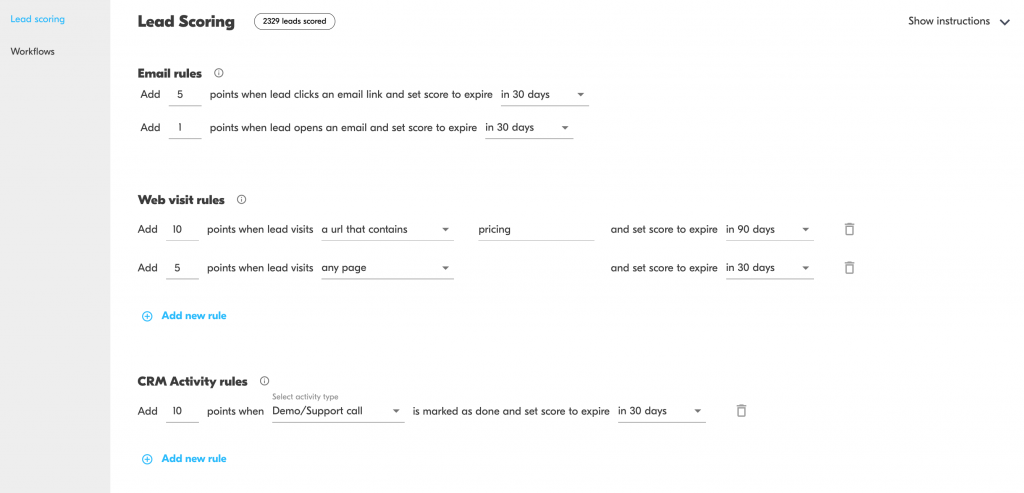
A shameless pitch: check out our lead scoring software if the above example sounds relevant
4. Last but not least, it’s all about people.
None of the strategies or tactics will work unless your team is on board, aligned with revenue marketing goals and equipped with the knowledge and know-how to push forward.
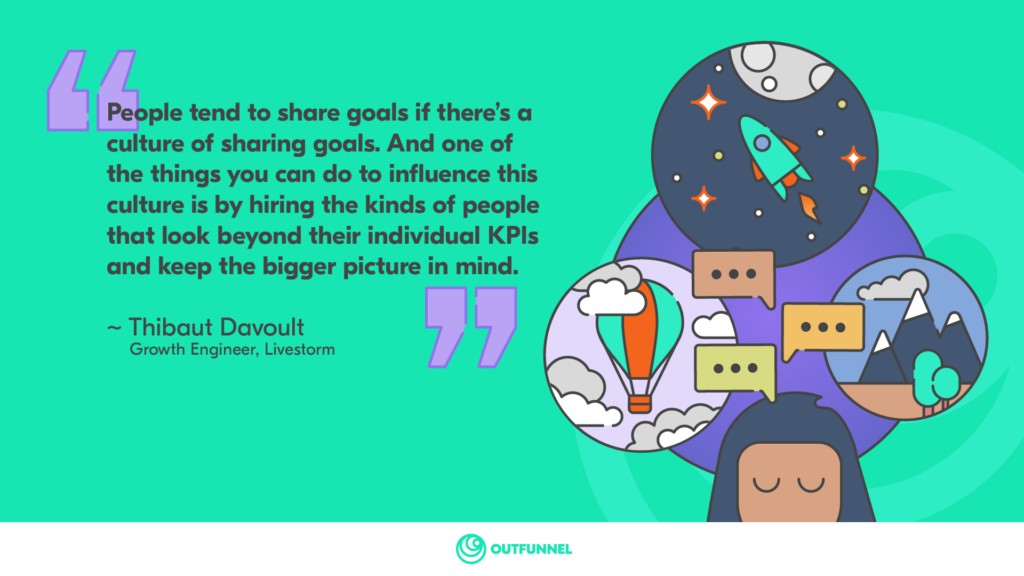
For example, Userlike has achieved this with formalized communication and clear goal-setting. They have weekly calls between the sales and marketing leads, bi-weekly “synergy meetings”, attended by representatives from marketing, sales, and support, as well as a quarterly discussion evening attended by the entire company.
Help Scout keeps their sales, marketing, and support aligned with shared KPIs and a single North Star: customer experience. They have cultivated a culture of collaborative learning, where the teams are focused on understanding why numbers are going up or down in relation to whatever changes were made.
Livestorm’s KPIs are linked to the different stages of their funnel and each has an “Owner”. They also highlight the importance of sharing data, (over-)communication, and a culture of sharing goals for keeping sales and marketing in sync.
In conclusion, there are different approaches to keeping your people in sync. The key is to find what works for you and build an aligned revenue marketing-driven team. Read more about the state of revenue marketing in this post: How to Align Marketing and Sales: What Our Research Says

